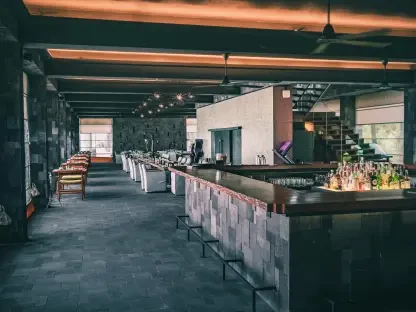Innovation is a driving force in the hospitality industry, constantly reshaping how hotels and resorts are designed to meet evolving guest expectations. As technology advances and creative boundaries are pushed, the future of hospitality design promises to be both exciting and transformative. Hoteliers and designers are now focusing on creating unique, sustainable, and technologically advanced spaces that offer personalized and memorable experiences to guests. The infusion of smart technology, sustainable practices, and creative design ideas is setting new standards for the industry.
The Role of Technology in Hospitality Design
Integrating Smart Technology
Smart technology is revolutionizing the way hotels operate and interact with guests. From automated check-ins to smart room controls, technology is enhancing convenience and personalization. Guests can now control lighting, temperature, and entertainment systems through their smartphones, creating a seamless and customized experience. This integration of smart technology not only improves guest satisfaction but also streamlines hotel operations, making them more efficient and cost-effective. Automated systems reduce human error and allow staff to focus more on providing exceptional service.
Moreover, smart technology extends beyond guest rooms. Hotels are incorporating intelligent energy management systems that optimize energy usage based on occupancy patterns. This not only leads to significant cost savings but also aligns with sustainable practices. Furthermore, smart technology enables predictive maintenance of hotel facilities, preventing costly downtime and ensuring that everything runs smoothly. The use of chatbots and AI-driven customer service platforms also enhances guest interactions, providing quick and efficient solutions to guest queries and concerns.
Virtual and Augmented Reality
Virtual and augmented reality (VR and AR) are becoming valuable tools in the design process. Designers can create immersive 3D models of hotel spaces, allowing stakeholders to visualize and experience the design before construction begins. This technology enables more accurate planning and reduces the risk of costly design changes later on. Through virtual walkthroughs, stakeholders can provide feedback, ensuring that the final design meets their expectations. These virtual models also facilitate better communication among the design team, contractors, and hotel management.
Additionally, VR and AR can be used to enhance guest experiences, such as virtual tours of hotel amenities or interactive room features. Guests can explore the hotel’s offerings virtually before their stay, aiding in decision-making and enhancing anticipation for the visit. For example, potential guests can take a virtual tour of a hotel’s spa, restaurant, or event spaces, making it easier to choose the perfect accommodation for their needs. AR can also be employed within the hotel, offering guests interactive guides to local attractions, menus, and hotel services through their smartphones or AR glasses.
Sustainable Design Practices
Eco-Friendly Materials and Construction
Sustainability is a key consideration in modern hospitality design. The use of eco-friendly materials and construction methods is becoming increasingly important as hotels strive to reduce their environmental impact. Recycled materials, energy-efficient systems, and sustainable building practices are being incorporated into new hotel designs. This not only benefits the environment but also appeals to eco-conscious travelers who prioritize sustainability in their travel choices. Incorporating elements like green roofs, solar panels, and energy-efficient windows can significantly reduce a hotel’s carbon footprint.
Hoteliers are also exploring the use of locally sourced and minimally processed materials to minimize transportation emissions and support local economies. Bamboo, reclaimed wood, and natural stone are some examples of eco-friendly materials gaining popularity. Furthermore, eco-friendly interior design focuses on non-toxic finishes and furnishings, contributing to better indoor air quality and guest health. Design elements such as energy-efficient lighting, water-saving fixtures, and smart HVAC systems further enhance a hotel’s sustainability.
Energy Efficiency and Waste Reduction
Energy efficiency and waste reduction are critical components of sustainable hotel design. Innovations such as solar panels, energy-efficient lighting, and water-saving fixtures help reduce a hotel’s carbon footprint. Additionally, waste reduction initiatives, such as composting and recycling programs, are being implemented to minimize the environmental impact of hotel operations. These practices not only contribute to a greener planet but also result in cost savings for hotel owners. Energy-efficient appliances and systems reduce utility bills, while waste reduction programs reduce disposal costs.
Hotels are also adopting zero-waste principles by eliminating single-use plastics and opting for reusable or biodegradable alternatives. This includes providing guests with refillable toiletry dispensers and encouraging the use of reusable water bottles. Kitchen operations are moving towards sourcing ingredients locally and reducing food waste through better inventory management and composting programs. By adopting circular economy practices, hotels can ensure that resources are used efficiently and waste is minimized, reinforcing their commitment to sustainability and attracting eco-minded travelers.
The Importance of Brand Differentiation
Customizing Design for Regional Needs
Brand differentiation is essential in the competitive hospitality market. Each hotel brand must carve out its unique identity while catering to regional needs and market expectations. Customizing design elements to reflect local culture and preferences helps create a distinctive and memorable guest experience. For example, incorporating local art, materials, and design motifs can make a hotel feel more authentic and connected to its surroundings. Hotels that embrace the local culture can offer guests a more enriching and immersive experience, setting themselves apart from the competition.
Furthermore, regional customization goes beyond aesthetics. It involves tailoring services, amenities, and culinary offerings to meet the specific preferences of the target market. For instance, a hotel in a tropical location might focus on outdoor experiences and wellness programs, while a city hotel might emphasize business facilities and connectivity. By aligning design and service elements with regional characteristics, hotels can create a sense of place and offer guests a unique and personalized stay that resonates with the local environment.
Balancing Brand Guidelines and Creative Freedom
While maintaining brand consistency is important, allowing for creative freedom within brand guidelines can lead to innovative and unique designs. Striking the right balance between adhering to brand standards and encouraging creativity ensures that each hotel stands out while still aligning with the overall brand identity. This approach fosters a sense of individuality and innovation, making each property a unique destination. Designers are encouraged to experiment with new ideas and materials, resulting in dynamic and captivating spaces that attract guests.
However, it’s crucial to ensure that creative freedom does not compromise brand integrity. Clear communication and collaboration between corporate design teams and local designers are essential to achieve this balance. Brand guidelines should serve as a framework that provides direction while allowing room for local adaptations. Encouraging designers to infuse their creativity within these guidelines can lead to the development of iconic and memorable spaces that elevate the brand’s reputation. This synergy between standardization and creativity is key to successful and impactful hotel design.
Collaboration with Suppliers and Stakeholders
Building Strong Supplier Relationships
Collaboration with suppliers is crucial in bringing design concepts to life. Suppliers play an integral role in executing the creative vision of interior designers. Building strong relationships with suppliers ensures that the materials and products used in hotel design meet the desired quality and aesthetic standards. This partnership is essential for transforming innovative ideas into tangible realities. Suppliers who are invested in the project’s success are more likely to ensure timely delivery and adherence to specifications.
Regular communication and involvement of suppliers from the early stages of the design process can prevent potential issues and ensure smooth execution. Establishing trust and fostering long-term partnerships with suppliers can also lead to better pricing, exclusive access to new materials, and collaborative innovation. For example, a strong supplier relationship may result in the development of custom furniture or fixtures that perfectly align with the hotel’s design concept. This level of collaboration ultimately enhances the overall quality and uniqueness of the final product.
Engaging Stakeholders in the Design Process
Engaging various stakeholders, including hotel owners, operators, and guests, in the design process is vital for creating successful hospitality spaces. Collaboration with these stakeholders helps ensure that the design meets practical requirements and enhances the overall guest experience. By involving stakeholders early in the design process, designers can address potential challenges and incorporate valuable feedback, resulting in a more cohesive and functional design. Stakeholders’ insights into operational efficiency, guest preferences, and market trends are invaluable in shaping effective design solutions.
For instance, input from hotel operators can provide practical insights into the layout and functionality of spaces, ensuring that designs are both aesthetically pleasing and operationally efficient. Engaging guests through surveys and feedback sessions can reveal expectations and preferences that can be incorporated into design elements. This collaborative approach fosters a sense of ownership and alignment among all parties involved, leading to designs that are well-received and successful in the long-term. It also ensures that the final design is both innovative and functional, catering to the needs of all users.
The Future of Hospitality Design
Embracing Bold and Unconventional Ideas
The future of hospitality design lies in embracing bold and unconventional ideas. Pushing creative boundaries and exploring avant-garde concepts can lead to distinctive and memorable hotel designs. Designers who propose innovative and daring ideas, even if they require moderation, contribute to the evolution of the industry. This approach ensures that hotels remain fresh, exciting, and relevant in a constantly changing market. The willingness to experiment and take calculated risks can result in iconic properties that capture the imagination of guests and set new industry standards.
Moreover, bold designs can create unique selling points that differentiate hotels from their competitors. Whether through striking architecture, innovative interior layouts, or cutting-edge amenities, these visionary concepts can attract attention and inspire loyalty among guests. Hotels that encourage creativity and forward-thinking are likely to stay ahead of market trends and continue to attract design-savvy travelers seeking unique and memorable experiences. The hospitality industry thrives on novelty and innovation, and bold designs play a crucial role in maintaining this dynamism.
The Role of Artificial Intelligence
Innovation drives the hospitality industry, constantly transforming how hotels and resorts are designed to keep up with changing guest expectations. With technological advancements and creative boundaries being expanded, the future of hospitality design is set to be both thrilling and transformative. Today, hoteliers and designers prioritize crafting unique, sustainable, and tech-savvy environments that offer personalized, unforgettable experiences for guests. The integration of smart technologies, eco-friendly practices, and inventive design concepts is raising the bar for the industry’s standards.
Currently, guests desire more than just a place to stay; they’re looking for immersive experiences that blend luxury with functionality. Smart rooms equipped with voice-activated controls, personalized lighting and temperature settings, and high-speed internet are becoming the norm. Further, sustainability is not just a trend but a necessity. Hotels are increasingly implementing green practices, such as using recycled materials, reducing water and energy consumption, and sourcing locally produced goods. Consequently, these efforts are driving the hospitality industry toward a future that is innovative, eco-conscious, and guest-focused.









